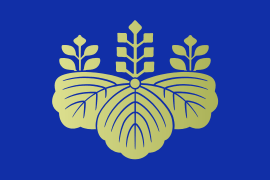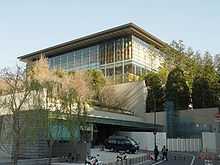Prime Minister of Japan
| Prime Minister of Japan 内閣総理大臣 | |
|---|---|
|
Official Emblem of the Prime Minister of Japan | |
| Style | His Excellency |
| Residence | Kantei |
| Appointer | HIM The Emperor |
| Term length | Since 1947: Four years or less. (The Cabinet shall resign en masse after a general election of members of the House of Representatives. Their term of office is four years and can be terminated earlier. No limits are imposed on total times or length of Prime Minister tenures of the same person.) The Prime Minister is, by convention, the leader of the victorious party, though some prime ministers have been elected who were from junior coalition partners or minority parties. |
| Inaugural holder | Itō Hirobumi |
| Formation | December 22, 1885 |
| Website | www.kantei.go.jp |
 |
| This article is part of a series on the politics and government of Japan |
|
Related topics |
|
Politics portal |
The Prime Minister of Japan (内閣総理大臣 Naikaku-sōri-daijin) is the head of government of Japan. He is appointed by the Emperor of Japan after being designated by the Diet from among its members and must enjoy the confidence of the House of Representatives to remain in office. He is the head of the Cabinet and appoints and dismisses the Ministers of State; the literal translation of the Japanese name for the office is Minister for the Comprehensive Administration of the Cabinet or Minister who Presides over the Cabinet.
The office was created in 1885,[1] four years before the enactment of the Meiji Constitution which mentions neither cabinet nor prime minister explicitly.[2][3] It took its current form with the adoption of the current constitution in 1947.
The current Prime Minister is Shinzō Abe, who took office on December 26, 2012. He is the first former Prime Minister to resume the office since 1948.
Appointment
The Prime Minister is designated by both houses of the Diet, before the conduct of any other business. For that purpose, each conducts a ballot under the run-off system. If the two houses choose different individuals, then a joint committee of both houses is appointed to agree on a common candidate. Ultimately, however, if the two houses do not agree within ten days, the decision of the House of Representatives is deemed to be that of the Diet. Therefore, the House of Representatives can theoretically ensure the appointment of any Prime Minister it wishes.[4] The candidate is then presented with their commission, and formally appointed to office by the Emperor.[5]
Qualifications
- Must be a member of either house of the Diet. (This implies a minimum age of 25 and a Japanese nationality requirement.)
- Must be a "civilian". This excludes serving members of the Japan Self-Defense Forces, as well as any former member of the Imperial Japanese Army and Imperial Japanese Navy, who are strongly connected to militarist thought. Note that former military officers from the World War II-era may be appointed prime minister despite the "civilian" requirement, Yasuhiro Nakasone being one prominent example.
Role
Constitutional roles
- Exercises "control and supervision" over the entire executive branch.[6]
- Presents bills to the Diet on behalf of the Cabinet.[7]
- Signs laws and Cabinet orders (along with other members of the Cabinet).[8]
- Appoints all Cabinet ministers, and can dismiss them at any time.[9]
- May permit legal action to be taken against Cabinet ministers.[10]
- Must make reports on domestic and foreign relations to the Diet.[7]
- Must report to the Diet upon demand to provide answers or explanations.[11]
- May advice the emperor to dissolve the Diet's House of Representatives.[12]
Statutory roles
- Presides over meetings of the Cabinet.[13]
- Commander in chief of the Japan Self-Defense Forces.[14]
- May override a court injunction against an administrative act upon showing of cause.[15]
Insignia
-

Standard of the Prime Minister
-

Emblem of the Prime Minister
-

Crest of the Prime Minister
Official office and residence

The Office of the Prime Minister of Japan is called the Kantei (官邸). The original Kantei served from 1929 until 2002, when a new building was inaugurated to serve as the current Kantei.[16] The old Kantei was then converted into the Official Residence, or Kōtei (公邸).[17] The Kōtei lies to the southwest of the Kantei, and is linked by a walkway.[17]
Honours and emoluments
Until the mid-1930s, the Prime Minister of Japan was normally granted a hereditary peerage (kazoku) prior to leaving office if he had not already been ennobled. Titles were usually bestowed in the ranks of count, viscount or baron, depending on the relative accomplishments and status of the Prime Minister. The two highest ranks, marquess and prince, were only bestowed upon highly distinguished statesmen, and were not granted to a Prime Minister after 1928. The last Prime Minister who was a peer was Baron Kijuro Shidehara, who served as Prime Minister from October 1945 to May 1946. The peerage was abolished when the Constitution of Japan came into effect in May 1947.
Certain eminent Prime Ministers have been awarded the Order of the Chrysanthemum, typically in the degree of Grand Cordon. The highest honour in the Japanese honours system, the Collar of the Order of the Chrysanthemum, has only been conferred upon select Prime Ministers and eminent statesmen; the last such award to a living Prime Minister was to Saionji Kinmochi in 1928. More often, the Order of the Chrysanthemum has been a posthumous distinction; the Collar of the order was last awarded posthumously to former Prime Minister Sato Eisaku in June 1975. The Grand Cordon has typically been posthumously awarded; the most recent such award was to Hashimoto Ryutaro in July 2006. Currently, Nakasone Yasuhiro is the only living former Prime Minister to hold the Grand Cordon of the Order of the Chrysanthemum, which he received in 1997.
After relinquishing office, the Prime Minister is normally accorded the second or senior third rank in the court order of precedence, and is usually raised to the senior second rank posthumously. Certain distinguished Prime Ministers have been posthumously raised to the first rank; the last such award was to Sato Eisaku in 1975. Since the 1920s, following their tenure in office, Prime Ministers have typically been conferred with the Grand Cordon of the Order of the Paulownia Flowers (until 2003 a special higher class of the Order of the Rising Sun), depending on tenure and eminence. However, honours may be withheld due to misconduct or refusal on the part of the Prime Minister (for example, Kiichi Miyazawa).
List of living former Prime Ministers
| Name | Term of office | Dates of birth |
|---|---|---|
| Yasuhiro Nakasone | 1982–1987 | May 27, 1918 |
| Toshiki Kaifu | 1989–1991 | January 2, 1931 |
| Morihiro Hosokawa | 1993–1994 | January 14, 1938 |
| Tsutomu Hata | 1994 | August 24, 1935 |
| Tomiichi Murayama | 1994–1996 | March 3, 1924 |
| Yoshirō Mori | 2000–2001 | July 14, 1937 |
| Junichiro Koizumi | 2001–2006 | January 8, 1942 |
| Yasuo Fukuda | 2007–2008 | July 16, 1936 |
| Taro Aso | 2008–2009 | September 20, 1940 |
| Yukio Hatoyama | 2009–2010 | February 11, 1947 |
| Naoto Kan | 2010–2011 | October 10, 1946 |
| Yoshihiko Noda | 2011–2012 | May 20, 1957 |
Lists of Prime Ministers of Japan
- List of Prime Ministers of Japan
- List of Japanese Prime Ministers by longevity
See also
References
- ↑ Legal framework for Prime Minister and Cabinet in the Empire: Dajōkan proclamation No. 69 of December 22, 1885 (内閣職権, naikaku shokken), later replaced by Imperial edict No. 135 of 1889 (内閣官制, naikaku kansei) in effect until 1947
- ↑ Article 55 of the Imperial Constitution only bound the ministers of state, i.e. all members of the cabinet including the prime minister, to "give their advice to the Emperor and be responsible for it."
- ↑ Kantei: Cabinet System of Japan
- ↑ Article 67 of the Constitution of Japan
- ↑ Article 6 of the Constitution of Japan
- ↑ Article 5 of the Constitution of Japan
- ↑ 7.0 7.1 Article 72 of the Constitution of Japan
- ↑ Article 74 of the Constitution of Japan
- ↑ Article 68 of the Constitution of Japan
- ↑ Article 75 of the Constitution of Japan
- ↑ Article 63 of the Constitution of Japan
- ↑ Article 7 of the Constitution of Japan
- ↑ Cabinet Act2012, article 4
- ↑ Self-Defense Forces Act of 1954
- ↑ Administrative Litigation Act, article 27
- ↑ Nakata, Hiroko (March 6, 2007). "The prime minister's official hub". The Japan Times Online (The Japan Times). Retrieved October 21, 2007.
- ↑ 17.0 17.1 "A virtual tour of the former Kantei – Annex etc. – The Residential Area". Prime Minister of Japan. Retrieved October 21, 2007.
- Kenkyusha's New Japanese-English Dictionary, Kenkyusha Limited, Tokyo 1991, ISBN 4-7674-2015-6
External links
| Wikimedia Commons has media related to Prime ministers of Japan. |
- Prime Minister of Japan and His Cabinet Official website
- List of Japanese cabinets 1885 to 1989 (Japanese)
| |||||||||||||||||||||||||||||||||||||||||||||||
